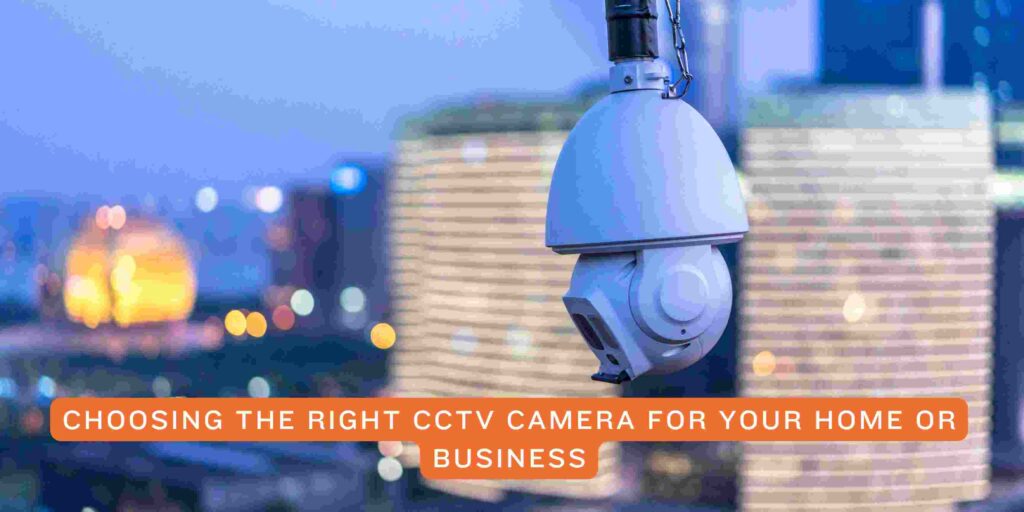
Selecting the right CCTV (Closed-Circuit Television) camera for your home or business is a crucial decision that can significantly impact the security and safety of your property, assets, and loved ones. With a wide variety of CCTV cameras available in the market, each with its own features, specifications, and capabilities, choosing the most suitable option can be overwhelming. This blog post aims to guide you through the key considerations and factors to help you make an informed decision when selecting a CCTV camera for your home or business.
1. Determine Your Surveillance Needs
The first step in choosing the right CCTV camera is to identify your specific surveillance needs and objectives. Consider the following factors:
- Location and Coverage: Determine the areas you want to monitor and the level of coverage required (wide-angle, narrow-angle, or panoramic).
- Indoor vs. Outdoor: Choose between indoor cameras suitable for monitoring indoor spaces or weatherproof outdoor cameras designed to withstand varying weather conditions and temperatures.
- Day/Night Capability: Opt for cameras with day/night or low-light capabilities to ensure clear and high-quality footage in both daytime and nighttime conditions.
2. Consider Camera Resolution and Image Quality
Camera resolution and image quality are crucial factors that determine the clarity and detail of the footage captured by the CCTV camera. Higher resolution cameras, such as Full HD (1080p) or Ultra HD (4K), offer sharper and more detailed images, making it easier to identify faces, objects, and activities. However, it’s essential to balance resolution with storage and bandwidth considerations, especially when recording and storing high-definition footage.
3. Evaluate Camera Features and Capabilities
Different CCTV cameras come with various features and capabilities designed to enhance performance, functionality, and user experience. Consider the following features when evaluating CCTV camera options:
- Motion Detection: Cameras with motion detection capabilities can automatically trigger recording or send notifications/alerts when motion is detected, helping to conserve storage space and reduce false alarms.
- Remote Access and Monitoring: Opt for cameras that offer remote access and monitoring capabilities, allowing you to view live or recorded footage, adjust camera settings, and receive alerts on your smartphone, tablet, or computer from anywhere, anytime.
- Two-Way Audio: Cameras with two-way audio capabilities enable you to communicate in real-time with visitors, employees, or family members, enhancing security, convenience, and interaction.
- Night Vision and Infrared (IR) LEDs: Choose cameras equipped with infrared (IR) LEDs or night vision capabilities to capture clear and detailed footage in low-light or nighttime conditions, ensuring round-the-clock surveillance and security.
4. Consider Camera Connectivity and Compatibility
When choosing a CCTV camera, consider its connectivity options and compatibility with existing or planned surveillance systems, networks, and devices. Evaluate the following connectivity features:
- Wired vs. Wireless: Decide between wired cameras that require a physical connection to a recording device or network and wireless cameras that use Wi-Fi or cellular connectivity for flexible installation and placement options.
- Power Source: Determine the camera’s power source (AC power, battery-powered, or Power over Ethernet) based on your installation requirements and preferences.
- Integration and Compatibility: Ensure the CCTV camera is compatible with your existing surveillance infrastructure, software, apps, and devices, or consider investing in a scalable and flexible system that supports integration with future technologies and platforms.
5. Set a Budget and Consider Total Cost of Ownership (TCO)
Before purchasing a CCTV camera, establish a realistic budget based on your surveillance needs, preferences, and available resources. Consider not only the initial purchase price but also the total cost of ownership (TCO), including installation, setup, maintenance, support, and potential future upgrades or expansions. Evaluate different pricing models, packages, and options to find a cost-effective solution that offers the best value, performance, and return on investment (ROI) for your home or business.
Conclusion
Choosing the right CCTV camera for your home or business is a critical decision that requires careful planning, research, and consideration of various factors, such as surveillance needs, location, coverage, resolution, image quality, features, capabilities, connectivity, compatibility, budget, and total cost of ownership (TCO). By evaluating your specific requirements, preferences, and priorities and comparing different CCTV camera options based on these criteria, you can make an informed decision, select the most suitable camera for your surveillance needs, and enhance the security, safety, and peace of mind of your property, assets, and loved ones.


